Has any one fed there fish bananas? I know Joe has but I was wondering if anyone else has tried it? Today I put a small peice of a banana in the tank. At first they all avoided the banana but moved around like they could sence there was food somewhere in the tank. My Hippo tang was the first to try the banana and took 2 bites and moved on. I came back an hour later and could not find the banana. I added another small piece and the yellow tang and the hippo ate a little more and then stopped. Again later when I went back it was gone. Do all fish like bananas? Does it take time for them to realize it as food?
My tangs did the same. The wrasse really dug it. Try some zuchini, the tangs liked that much better.
And so it begins. Actually, it began about five years ago.
I was living in Bloomington, Indiana at the time. Nano-reefs were the new frontier in reef keeping and every discussion board was filled with hobbyists discussing cubes cracking or pods overheating. I had gone with the 12 Gallon Nanocube myself and after a few months of cycling I took at trip out to Inland Aquatics to do some stocking. I set out that morning to buy some soft corals but I ended up with a new appreciation for the art of clownfish breeding. I went home with a pair of “Onyx” Percs for $499.
A few years later, I found myself stocking a new reef system and had fallen in love with the unique quality of the “Picasso” Percula. There was a huge waiting list at my LFS to obtain one. After a 6 month wait, my LFS called to tell me they had some ORA Grade A Picasso Percs in stock. The selection was terrible.
That had settled it for me. I was tired of waiting and sick of the ridiculous prices for mediocre specimens. I’ve had over twenty years of experience in this hobby. How hard can breeding Picasso Clownfish be?
- The Design Concept -
I’m going to fast forward a bit. I’ve moved back to Delaware now. I’ve read Joyce Wilkerson’s book cover to cover. I’ve also followed other people’s logs as they try to adventure into aquaculturing marine fish. Here’s my design concept for the Brood Stock Tank with an attached Grow-Out Tank.
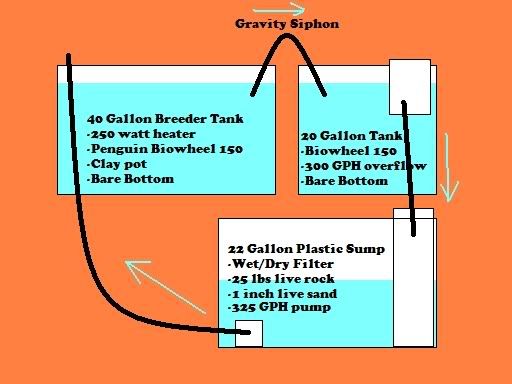
So what I’ve done here is piggyback a 20 Gallon Tank onto a 40 Gallon Breeder Tank and 22 Gallon Sump/Refugium. Water begins in the Sump/Refugium where it is pumped at 325 gph into the 40 Gallon Breeder. As the water level rises, water is transported through a 1" Gravity Siphon into the 20 Gallon Tank. As the water fills the 20 Gallon tank, it dumps into an overflow box which funnels it back down through a wet/dry filter into the Sump/Refugium.
- DIY Components -
Stands - So what fun would this be if I didn’t make some DIY mistakes along the way? The first disaster was trying to save money on the stands. I’m too embarrassed to post a pic of the PVC/Wood hybrid looking stands I made for under $20. They were level, I’ll give them that. But there was no way they’d support the weight over time. I replaced them with some steel stands I got at the Home Depot for $50 that can support 1,000 lbs per shelf.
Wet/Dry - I drilled a couple holes in a 4 inch PVC pipe and filled it with bioballs. BAM! Wet/Dry Filter.
22 Gallon Sump - This baby was a real steal at the Home Depot. I had to research plastics a bit but most food-safe plastics are safe. I drilled a hole for the Wet/Dry PVC pipe and a window for a coralife power compact light fixture. There’s 1 inch of live argonite sand in there along with about 25 lbs of live rock.
- Tank Cycling/Initial Setup -
40 Gallon Breeder Tank, 20 Gallon Grow-Out Tank, 22 Gallon Sump/Refugium.
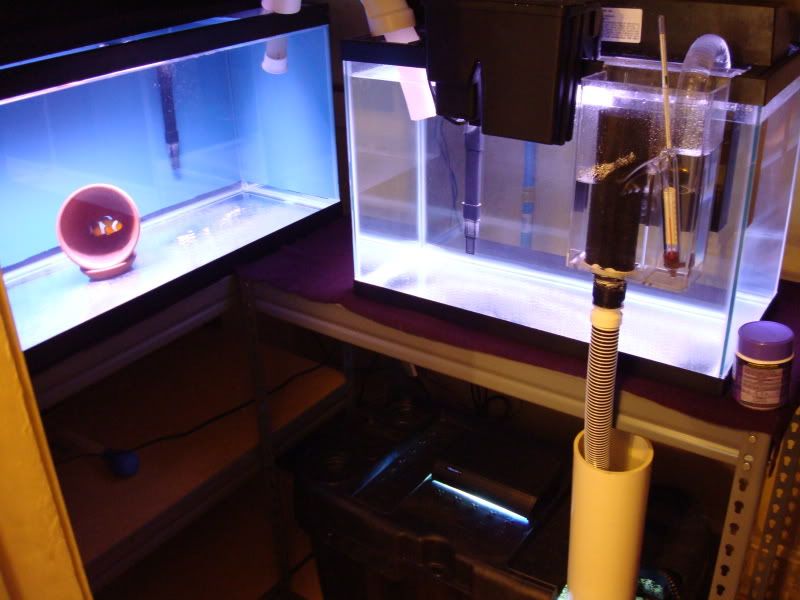
40 Gallon Breeder with an Amphiprion ocellaris lending a hand with the cycling process.
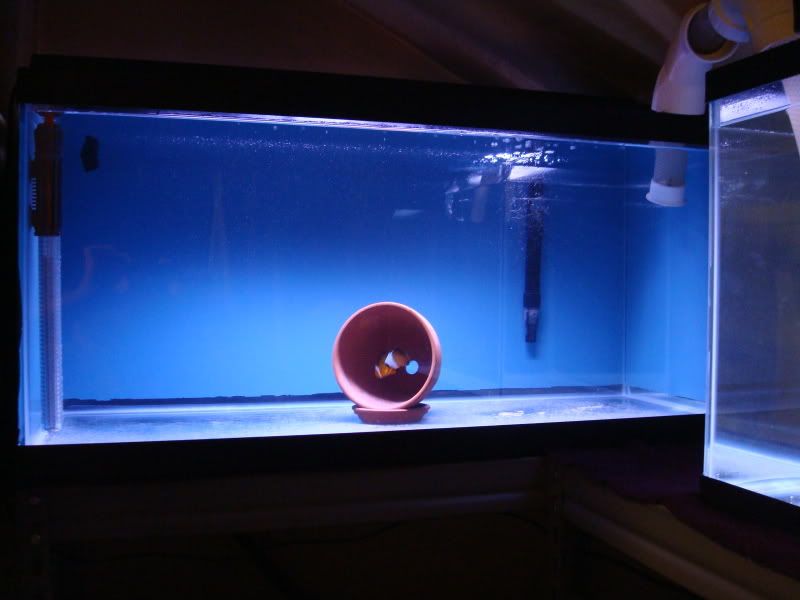
She is a bit camera shy. And she is anxious to get back to her 90 Gallon once her job is done!
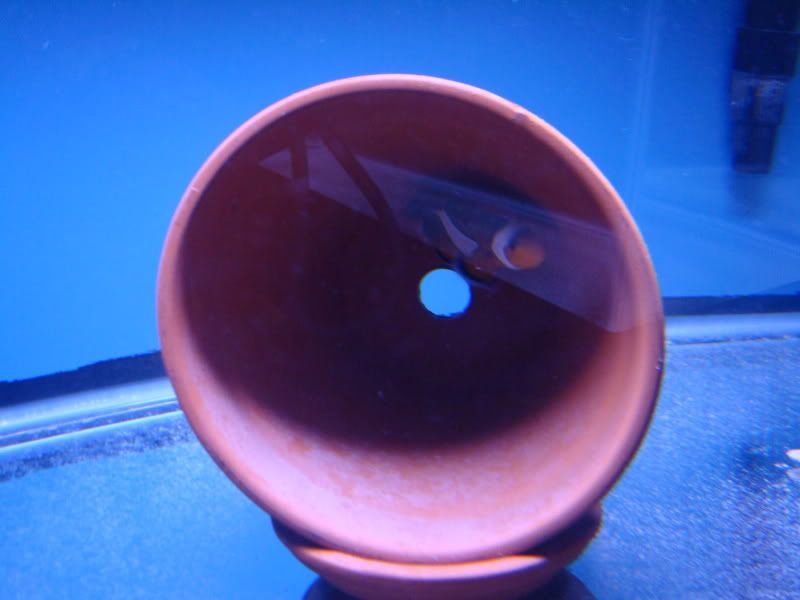
First Brown Diatom Algae growth on the Clay Flower Pot.
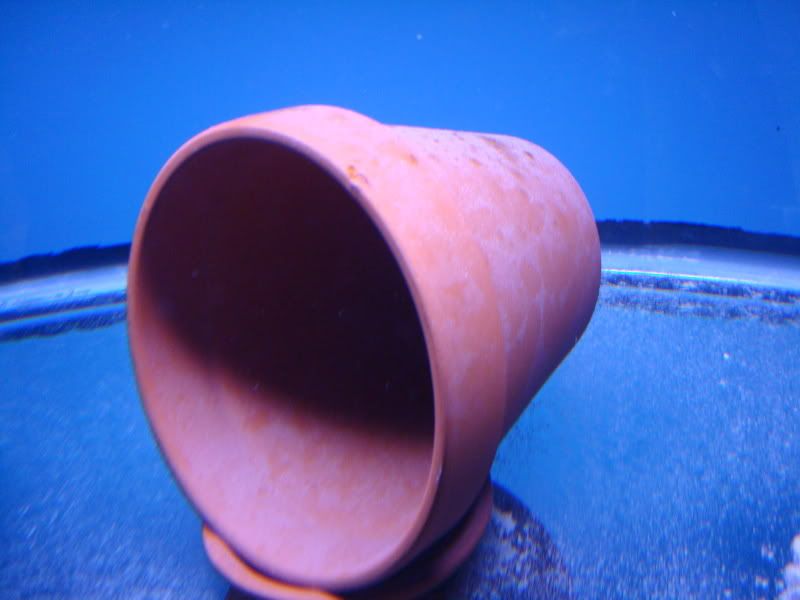
Lighting for 22 Gallon Sump/Refugium.
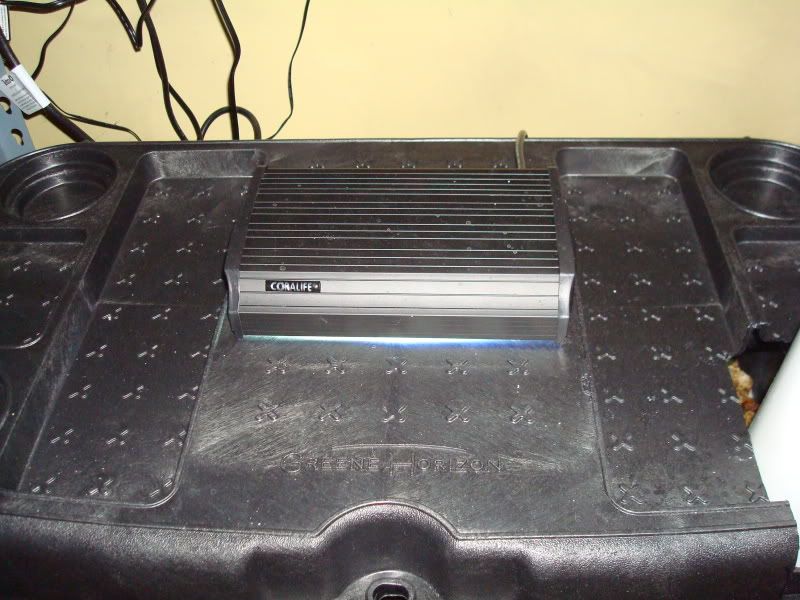
Live Rock and Live Sand Refugium.
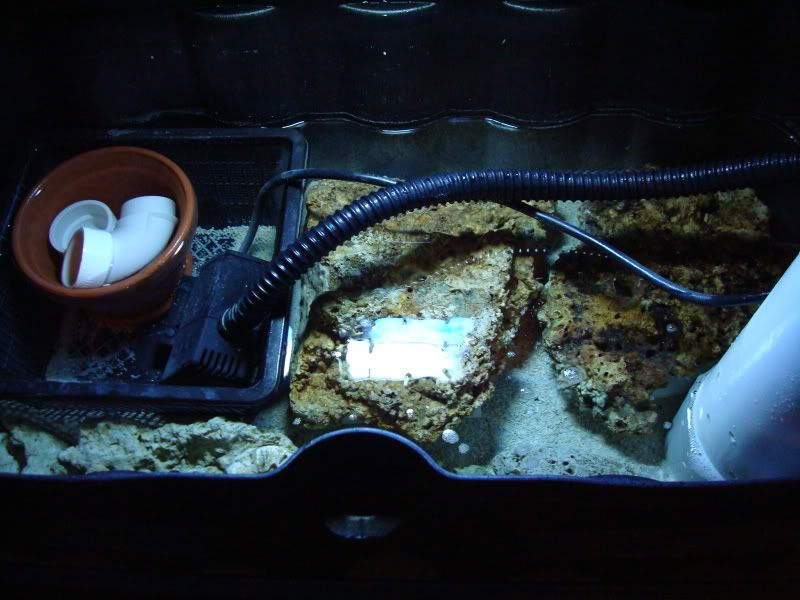
- Current Log Updates -
09.09.09. DIY Stands assembled and Tanks put into position for leveling.
09.12.09 Tap water added for leak testing.
09.13.09 Tanks drained after discovering PVC shelving had “settled” almost 1/4" overnight and Breeder Tank appeared to be leaning diagonally forward. Broke down entire setup.
09.14.09 Consulted with my dad who was a mechanical engineer about the stands. Opted to scrap the DIY stands and purchased Home Depot steel stands rated for 1,000 lbs per shelf. Re-assembled. Filled with tap water.
09.15.09 Leak test passed. Added hardware and began circulating the water. Discovered design flaw with the DIY Gravity Siphon. I thought a 3/4" tube would easily transfer 300 gph. It didn’t. The Gravity Siphon wasn’t working fast enough. Went to Home Depot and upgraded to 1" tubing. That did the trick. Added Salt to the system.
09.16.09 Added Live Sand to the Sump.
09.25.09 Added Live Rock to the Sump.
09.27.09 Discovered a leak in the overflow box where it connects to the flex tubing. Fixed it.
09.28.09 Discovered another leak in the overflow box where it connects to the flex tubing. Fixed it.
09.30.09 Discovered yet another leak in the overflow box where it connnects to the flex tubing. Added enough Silicon to reinforce the Hoover Dam.
10.05.09 Added 5 year old Amphiprion ocellaris to assist with cycling.
10.08.09 Discovered first Brown Diatom Algae growth. Also noticed dozens of Copepods and Amphipods throughout the entire system.
10.10.09 New Jersey LFS emailed me saying that although they had promised me some brood stock, the ORA Picassos from the MACNA showcase they had received would be going to Hong Kong instead.
oo… so basically you just got skrewed out of the fish you built this entire set up for?.. so what more waiting, looks cool… i dont really know much about this, i know ken raised some kindof clowns… interesting though, hope to see what come of it…
nice set up. hope it all work out for u. cant wait to see how it all does.
I’ve spent the better part of a year looking for a nice pair of Picasso Percs. I’ve seen hundreds online and dozens in the stores. But I haven’t been satisfied with any just yet. This pair would probably have been the first that would have made nice brood stock.
I hope they’re happy in Hong Kong!
Bet they would, ORA would only bring the best to macna, and man were there some nice fish in that tank…
there are a few members on this forum who breed clownfish. it might be helpful to get into contact with them, hopefully someone chimes in with their contact info.
The only thing I would suggest is drilling the tanks. Gravity overflows are just problems waiting to happen.
Well I find that Gravity is pretty constant.
(I’m willing to bet at least someone found that funny.)
But I hear what you’re saying. If I were connecting a dozen tanks, I’d drill for sure. My setup uses two gravity siphons, the one in the overflow and the big one between the tanks (which is I assume what concerns you). It’s pretty stable and the only maintenance seems to be giving it a little shake at least once a week when the micro bubbles start to add up. It’s been running for over a month and there’s no signs that it isn’t doing it’s job adequately. It’s also pretty heavy when it’s full. There’s no way for it to slip.
The advantage of doing it this way is that I’m free to break down the setup. Which is my main reason for not drilling!
Final Preparations
This past Sunday I purchased six Picasso clowns! They came from a breeder out of North Carolina and I’m able to trace the lineage back two generations for sure.
The paternal grandparents came from ORA (where they were selectively bred for who knows how long) and the maternal grandparents lived in the Solomon Islands. The next generation were the parents of my fish, a Snowcasso (from the ORA Picassos) and a WC True Perc (from the Solomon Islands percs). I think adding the Solomon Island fish into the mix helped with the gene pool a bit and also changed the color pattern slightly for the better.
With six fish on the way, I had decided to pair them from Day 1 within three separate broodstock tanks. To accomplish this, I built a DIY Divider for the 40 Gallon Breeder using eggcrate and plastic canvas sheets. I’ve also added some vibrant looking fake plants from Tetra that I’m hoping will make the fish feel more secure and encourage good coloration.
Here we have the DIY Divider and new Aquascaping:
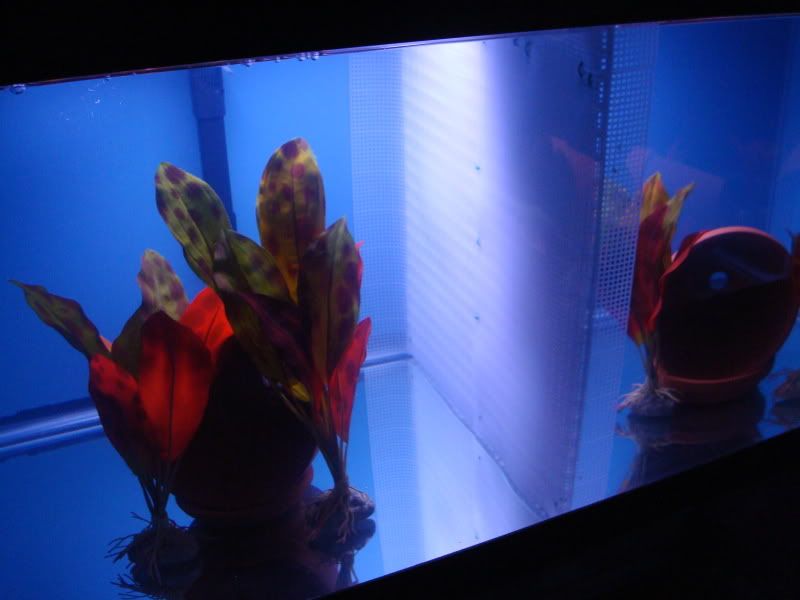
Again the divider with some new inhabitants!
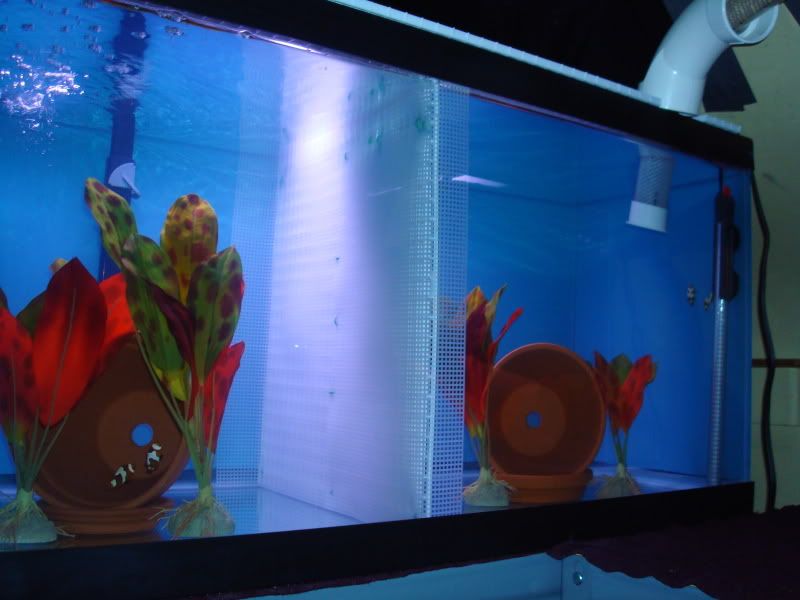
The little guys arrived around 10AM this morning via UPS overnight in breathable Kordon bags. Several of them actually looked quite happy, others were clearly in shock. But within minutes of beginning to acclimate they all looked fine. I couldn’t believe that any of them had already formed any strong bonds so I took it upon myself to pair them up as I saw fit.
Michigan & Niles
The first pair I made was Michigan & Niles (these names probably aren’t permanent, just an easy way for me to ID them for now.) I hate to show favoritism early on, but these are my favorite. Michigan looks like… well, Michigan. Niles has a beautiful flowing pattern from tail to midsection, like a winding river. The camera I’m using is digital and I’m forced to focus on the glass then move the camera forward a few inches in an attempt to get a clear focus. It’s really hit or miss and I spent the most time trying to capture these two. Back to the pics!
Michigan & Niles
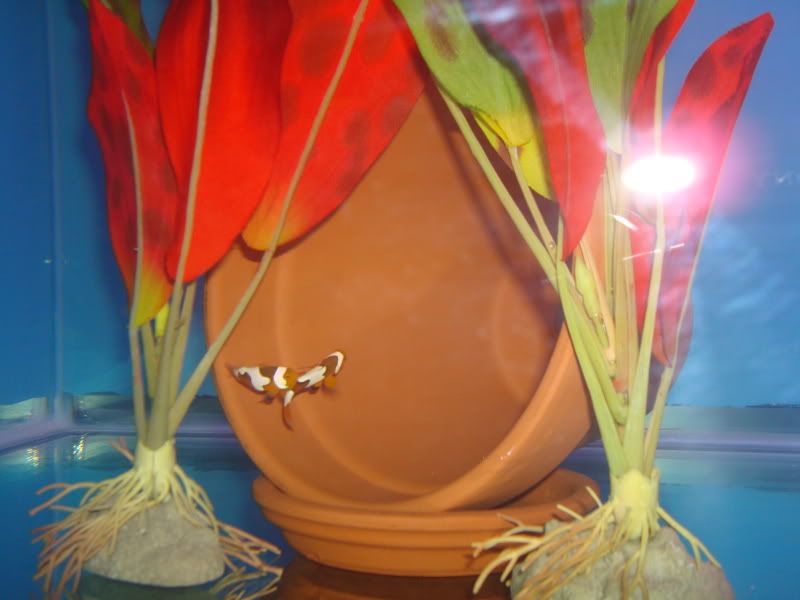
Good shot of Niles (lower right)

Good shot of Michigan (lower)

Spot & Blotch
I know the names are terrible and the pics are equally as bad. Of the three pairs, this was the only pair to show immediate signs of aggression and territory disputes. Spot appears to have taken over the flower pot and poor Blotch is hiding up by the heater. Spot is without a doubt the aggressor. It has a distinct spot in its white midsection which you really can’t see in the pic. Blotch has a huge blotch of white on its cheek which you again can’t make out in this pic.
Spot

Blotch

White Tip & Mako
The final pair is White Tip and Mako. They are the lone pair in the 20 Gallon and seem to like hiding out behind the flower pot rather than inside of it. White Tip has a completely white Dorsal Fin. It’s not the only fish to have that characteristic but it was showing it off very proudly early on and I think it’s going to look fantastic one day. Mako is a cool sounding shark name and I thought it went well with White Tip, thus the name.
White Tip & Mako

Finally I thought I’d leave you with some full tank shots. I’ve made sure to seal off every inch of the tanks since I’m prediciting some jumping that will be occuring over the next few months. I’m pretty proud of the new egg crate lid as well.
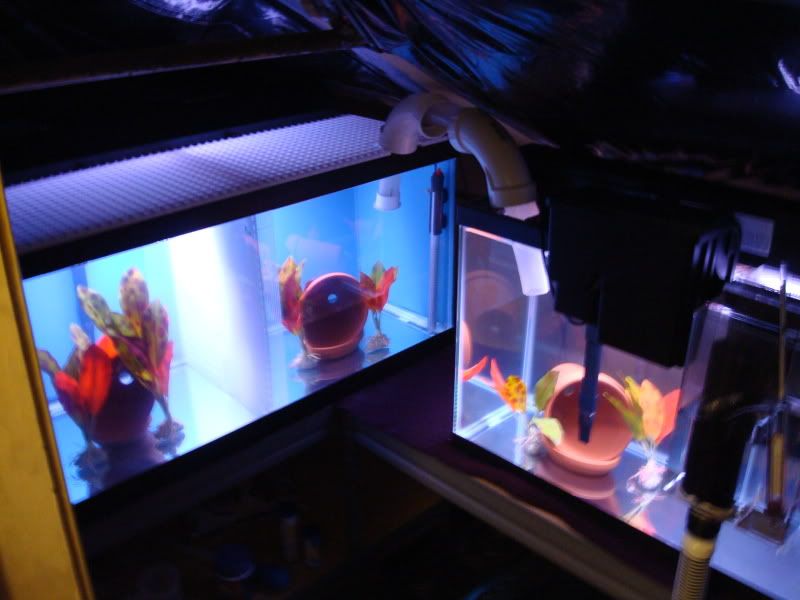

How do you know which are male and female, or can they change gender or sumthin like that. gratz on the fish, i dont wanna even know how much they cost. prob an arm and a leg.
yes clownfish can change gender. they all start out as males and can change to females. they can change back to males though.
i think he said they were kinda buddyed up in the box and just paired up the best he thought would be good together(maybe size or color).
wow, nice fish. cant wait to see how this works out. hope none of the fish deside to carpet surf, nice egg creat and good idea.
Technically, they start and stay gender neutral unless certain criteria are met.
In a social group of several clownfish, there will be one dominant male and one dominant female. The other fish repress certain hormones and will not advance into the sexual order unless something happens to a member of the dominant pair.
If a fish is left by itself or settles into a new home, it will almost always become female. The next fish to enter the group will become her partner and any additional fish will stay gender neutral. That’s why if you leave a clownfish alone in a tank for about a year, it will most likely be a female.
So the way this applies here, by separating the fish into groups of two, I should end up with three pairs of males and females within a few months. Even at the young age of 4-6 months, I can already see which of the fish is most likely going to become the female based on their body size and aggression. I’m betting on Michigan, Spot and White Tip becoming females while Niles, Blotch and Mako become males.
Females turning back into males has been documented but it’s my understanding that it is very rare.
Very cool. Looking forward to seeing your progress.
Females turning back into males has been documented but it's my understanding that it is very rare.agreed.
Technically, they start and stay gender neutral unless certain criteria are met.Fish breeding happens to be a subject im very interested in and have done quite a bit of reading. Correct me if im wrong, but i believe all clownfish are actually born "non sexual males" not gender neutral.
Another fascinating thing about clownfish, specifically species that live in family structures, are there ability to not only regulate their sex but their size. The family heirarchy is so rigid that social status is often determined by a size difference that is almost inperceptible to the human eye. Amazing fish. I have two pairs now, one that spawns regularly and im looking forward to putting together a large family structure in my new tank. Im really looking forward to any progress you make.
You know, I’m not exactly sure. I’ve never heard of them referred to as “non sexual males”.
Joyce’s book refers to them as adolescents that must make a physical transformation from adolescent to male and they will not do that until they have an opportunity to advance or until they start their own hierarchy elsewhere.
Based on that, I’d probably lean towards calling them gender neutral but I don’t exactly have a degree in icktheology here! :GEEK:
Have you documented any of your fish rearing adventures? I’d like to hear about them!
[quote=“Marchingbandjs, post:12, topic:573”]
How do you know which are male and female, or can they change gender or sumthin like that. gratz on the fish, i dont wanna even know how much they cost. prob an arm and a leg.[/quote]
Oh and I didn’t mean to skip the first part of this question. With Occys and True Perc clowns, the females are dominant and literally double the size of the males. As said before, they can regulate their growth rates through hormones when they become sexual. I’ll post pics of these clowns pretty regularly and it will become blatantly obvious who the females are.
DAMN, i just typed out the longest reply that timed out. anyways, ill try and do a quick recap. After a quick search, clownfish are all born male. I just thought you might be curious to know. Wilkerson’s book is a good read. Ive read about 90% of it. I also have some more advanced books on the subject if your ever interested i could let you borrow one if you want.
Have you documented any of your fish rearing adventures?I actually didnt even know they were spawning until a couple of months ago when i saw the eggs. I have a mated pair of maroons that spawn, and a pair of ORA black occs that have been paired for almost a year now but havent dislayed spawning behavior. I have too much on my plate now to pursue anything related to breeding other than planning/reading but when i do i want to start with the Kaudern's Cardinalfish for several reasons including their sometimes controversial status in the wild and the lack of larval stages. I know someone mentioned our local breeders alredy, but i will do so again. You should really reach out to ChrisandBarb and Kaptken. Chris and his wife has breed mutiple clownfish that im aware of including the brown saddleback(i think) which i also believe was one of the first, if not the first, instance of CB for that species. Ken has bred mutiple species of fish including both cardinalfish and clownfish. I believe both Chris and his wife as well as Ken still have active breeding projects. Ive picked Ken's brain, and Chris's vicariously through Ken, about a lot of details regarding husbrandy and larval care including sources for food and supplies. Between the three of them you should be able to figure out any questions you might have and maybe learn a couple of trickes or three. I wont regurgitate the info ive gotten from them here, but i urge you to reach out. I think its very cool what your doing. Im not a big fan of designer fish, but ive got to admit, the picassos are pretty awesome. It makes good sense to start a breeding project with a fish like the picasso and buying 3 pairs says a lot. Another good link to check out is www.donisreef.com. Im not sure if your familiar with it, but i believe she was one of the first to offer CB picassos other than ORA and a "larger" scale. She has a pretty sound reputation on the many boards and you might be able to get a few ideas regarding a business model from her site.
I wish you the best of luck and look forward to following your progress. I hope you keep this thread alive and updated.
kindof sounds like thats where he got them, breathable bags and stuff…
Yup, I got them from Woodstock AKA Doni. She’s based out of NC and her mega-thread was one of the first online resources I read. It’s also how I first met Chris and Barb.
I’m in daily contact with Chris and Barb on their website www.reef-geeks.com. We have a member over there from Australia who has a pair of Tomato Clowns that are actively spawning and we’re all discussing his first batch of fry as we speak.
Chris and Barb seem to have come up with an alternative feeding strategy for about 5 days into the larval stage that skips the brine shrimp napueli which I’m all about trying. I’d look forward to meeting CaptKen.
Of course, I’ll be teaching everyone a thing or two once I got my system down! :GOLD)
It’s interesting to hear that they do classify the non-sexual adolescents as males. I guess if you got the goods you’re a male whether or not they’re working! ;D